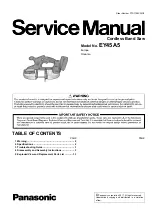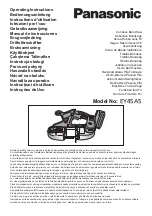
34
1. Move the sliding fence to proper position 1. (See Sliding Fence on page 32.)
2. Extend the table extension on the side of the table where hand support is needed to
properly support the workpiece. (see Table Extension section in page 31 .)
3. Loosen the bevel lock handle. Tilt the head assembly to desired bevel angle 2. Tighten
the bevel lock handle (Figure 30).
4. Properly position workpiece 3. Make sure workpiece is clamped 4 firmly against the table
and the fence 5.
WARNING
Use clamping position that does not interfere with operation. Before
switching on, lower head assembly to make sure clamp clears guard and
head assembly.
5. Activate the switch. Lower the head assembly and make your cut.
6. Wait until blade comes to a complete stop before returning head assembly to the raised
position and/or removing workpiece.
Cross Cut
•
A cross cut is cutting wood across the grain, or square with both the edge and the flat side of
the wood.
Follow these instructions for making your cross cut:
1. Properly position workpiece. Make sure workpiece is clamped firmly against the table and
the fence.
2. Extend the table extension on the side of the table where hand support is needed to
properly support the workpiece.(see Table Extension section in page 31.)
WARNING
Use clamping position that does not interfere with operation. Before
switching on, lower head assembly to make sure clamp clears guard and
head assembly.
3. Activate the switch. Lower the head assembly and make your cut.
4. Wait until blade comes to a complete stop before returning head assembly to the raised
position and/or removing workpiece.
Compound Cuts
•
A compound cut is a cut requiring both a
miter setting and a bevel setting.
•
Because it may take several tries to obtain
the desired compound angle, perform test
cuts on scrap material before making your
cut.
Follow these instructions for making your
compound cut:
1. Move sliding fence to proper position 1 (see
Sliding Fence on page 32).
2. Extend the table extension on the side of
the table where hand support is needed to
properly support the workpiece. (see Table
Extension section in page 31 .)
3. Select the desired miter 3 and bevel angles 4 (Figure 31).(See Miter Cut and Bevel Cut on
pages 33 and 34.)
6
1
4
4
2
3
0
5
Fig. 31
















































